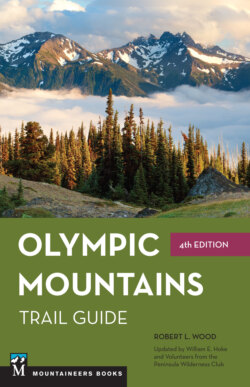Читать книгу Olympic Mountains Trail Guide - Robert Wood - Страница 33
На сайте Литреса книга снята с продажи.
ОглавлениеHigh alpine lakes and dramatic scenery abound in the Olympics (Hike 97).
PART I
LEEWARD OLYMPICS
The northern and eastern slopes of the Olympic Mountains constitute the leeward side because the prevailing winter winds at this latitude in the northern hemisphere come from the southwest. Accordingly, the leeward side is sheltered from storms by the Windward Olympics, the mass of peaks to the south and west. As a consequence, since they occupy what is called the rain shadow of the mountains, the northern and eastern slopes receive much less precipitation. The northeastern Olympics—or the Jupiter Hills as they were once called—have the lightest precipitation, from 20 to 30 inches yearly. As one goes west or south from the northeastern apex, the annual precipitation gradually increases (at the rate of about one inch per mile). Although these slopes lie within the bounds of the Leeward Olympics, they gradually phase into the windward belt at the western and southern extremities. Of course no sudden break occurs—one cannot draw a line and call one side the windward, the other the leeward. The boundary is approximate.
Because the northern and eastern sides of the Olympics are steeper than the southern and western slopes, the Leeward Olympics constitute only 40 percent of the total area included in the mountains. However, the peaks are generally higher in this section; therefore, the area contains as much if not more of the high country as do the Windward Olympics.
